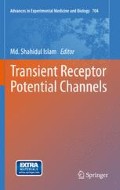Abstract
Microbes have made numerous contributions to the study of biology and medicine. Those contributions also include many original discovery’s in the study of ion channels often thought as the province of neuroscientists or cardiophysiologists. Yeast have long been used as a model organism and TRP channel genes and their transmembrane products touted as the “vanguards of the sensory system” can be identified in the genomes of many yeasts. This article aims to review the study of these TRP channels in yeast their discovery, electrophysiological properties and physiological function.
Access this chapter
Tax calculation will be finalised at checkout
Purchases are for personal use only
References
Martinac B, Buechner M, Delcour AH, Adler J, Kung C (1987) Pressure-sensitive ion channel in Escherichia coli. Proc Natl Acad Sci USA 84:2297–2301
Gustin MC, Martinac B, Saimi Y, Culbertson MR, Kung C (1986) Ion channels in yeast. Science 233:1195–1197
Sukharev SI, Blount P, Martinac B, Blattner FR, Kung C (1994) A large-conductance mechanosensitive channel in E. coli encoded by mscL alone. Nature 368: 265–268
Palmer CP, Zhou XL, Lin J, Loukin SH, Kung C, Saimi YA (2001) TRP homolog in Saccharomyces cerevisiae forms an intracellular Ca(2+)-permeable channel in the yeast vacuolar membrane. Proc Natl Acad Sci USA 98:7801–7805
Ketchum KA, Joiner WJ, Sellers AJ, Kaczmarek LK, Goldstein SA (1995) A new family of outwardly rectifying potassium channel proteins with two pore domains in tandem. Nature 376:690–695
Roux B, MacKinnon R (1999) The cavity and pore helices in the KcsA K+ channel: electrostatic stabilization of monovalent cations. Science 285:100–102
Adoutte A, Ling KY, Forte M, Ramanathan R, Nelson D, Kung C (1981) Ionic channels of Paramecium: from genetics and electrophysiology to biochemistry. J Physiol (Paris) 77:1145–1159
Mūller U, Malchow D, Hartung K (1986) Single ion channels in the slime mold Dictyostelium discoideum. Biochim Biophys Acta 857:287–290
Yoshimura K (1998) Mechanosensitive channels in the cell body of Chlamydomonas. J Membr Biol 166:149–155
Levina NN, Lew RR, Hyde GJ, Heath IB (1995) The roles of Ca2+ and plasma membrane ion channels in hyphal tip growth of Neurospora crassa. J Cell Sci 108:3405–3417
Zhou XL, Stumpf MA, Hoch HC, Kung C (1991) A mechanosensitive channel in whole cells and in membrane patches of the fungus Uromyces. Science 253:1415–1417
Zhou XL, Kung C (1992) A mechanosensitive ion channel in Schizosaccharomyces pombe. EMBO J 11:2869–2875
Gustin MC, Zhou XL, Martinac B, Kung C (1988) A mechanosensitive ion channel in the yeast plasma membrane. Science 242:762–765
Wolfe DM, Pearce DA (2006) Channeling studies in yeast: yeast as a model for channelopathies? Neuromol Med 8:279–306
Wada Y, Ohsumi Y, Tanifuji M, Kasai M, Anraku Y (1987) Vacuolar ion channel of the yeast, Saccharomyces cerevisiae. J Biol Chem 262:17260–17263
Bertl A, Slayman CL (1990) Cation-selective channels in the vacuolar membrane of Saccharomyces: dependence on calcium, redox state, and voltage. Proc Natl Acad Sci USA 87:7824–7828
Denis V, Cyert MS (2002) Internal Ca(2+) release in yeast is triggered by hypertonic shock and mediated by a TRP channel homologue. J Cell Biol 156:29–34
Yamaguchi T, Aharon GS, Sottosanto JB, Blumwald E (2005) Vacuolar Na+/H+ antiporter cation selectivity is regulated by calmodulin from within the vacuole in a Ca2+- and pH-dependent manner. Proc Natl Acad Sci USA 102:16107–16112
Zhou XL, Batiza AF, Loukin SH, Palmer CP, Kung C, Saimi Y (2003) The transient receptor potential channel on the yeast vacuole is mechanosensitive. Proc Natl Acad Sci USA 100:7105–7110
Zhou X, Su Z, Anishkin A, Haynes WJ, Friske EM, Loukin SH, Kung C, Saimi Y (2007) Yeast screens show aromatic residues at the end of the sixth helix anchor transient receptor potential channel gate. Proc Natl Acad Sci USA 104:15555–15559
Su Z, Zhou X, Loukin SH, Saimi Y, Kung C (2009) Mechanical force and cytoplasmic Ca(2+) activate yeast TRPY1 in parallel. J Membr Biol 227:141–150
Sabie FT, Gadd GM (1989) Involvement of a Ca2+-calmodulin interaction in the yeast-mycelial (Y-M) transition of Candida albicans. Mycopathologia 108:47–54
Zhou XL, Loukin SH, Coria R, Kung C, Saimi Y (2005) Heterologously expressed fungal transient receptor potential channels retain mechanosensitivity in vitro and osmotic response in vivo. Eur Biophys J 34:413–422
Calvert CM, Sanders D (1995) Inositol trisphosphate-dependent and -independent Ca2+ mobilization pathways at the vacuolar membrane of Candida albicans. J Biol Chem 270:7272–7280
Harris PC, Torres VE (2009) Polycystic kidney disease. Annu Rev Med 60:321–337
Tsiokas L (2009) Function and regulation of TRPP2 at the plasma membrane. Am J Physiol Renal Physiol 297:1–9
Zhou J (2009) Polycystins and primary cilia: primers for cell cycle progression. Annu Rev Physiol 71:83–113
Palmer CP, Aydar E, Djamgoz MB (2005) A microbial TRP-like polycystic-kidney-disease-related ion channel gene. Biochem J 387:211–219
Watnick TJ, Jin Y, Matunis E, Kernan MJ, Montell C (2003) A flagellar polycystin-2 homolog required for male fertility in Drosophila. Curr Biol 13:2179–2184
Aydar E, Palmer CP (2009) Polycystic kidney disease channel and synaptotagmin homologues play roles in schizosaccharomyces pombe cell wall synthesis/repair and membrane protein trafficking. J Membr Biol 229:141–152
Bok JW, Sone T, Silverman-Gavrila LB, Lew RR, Bowring FJ, Catcheside DE, Griffiths AJ (2001) Structure and function analysis of the calcium-related gene spray in Neurospora crassa. Fungal Genet Biol 32:145–158
Protchenko O, Rodriguez-Suarez R, Androphy R, Bussey H, Philpott CC (2006) A screen for genes of heme uptake identifies the FLC family required for import of FAD into the endoplasmic reticulum. J Biol Chem 281:21445–21457
Batiza AF, Schulz T, Masson PH (1996) Yeast respond to hypotonic shock with a calcium pulse. J Biol Chem 271:23357–23362
Author information
Authors and Affiliations
Corresponding author
Editor information
Editors and Affiliations
Rights and permissions
Copyright information
© 2011 Springer Science+Business Media B.V.
About this chapter
Cite this chapter
Kaleta, M., Palmer, C. (2011). TRP Channels in Yeast. In: Islam, M. (eds) Transient Receptor Potential Channels. Advances in Experimental Medicine and Biology, vol 704. Springer, Dordrecht. https://doi.org/10.1007/978-94-007-0265-3_17
Download citation
DOI: https://doi.org/10.1007/978-94-007-0265-3_17
Published:
Publisher Name: Springer, Dordrecht
Print ISBN: 978-94-007-0264-6
Online ISBN: 978-94-007-0265-3
eBook Packages: Biomedical and Life SciencesBiomedical and Life Sciences (R0)

